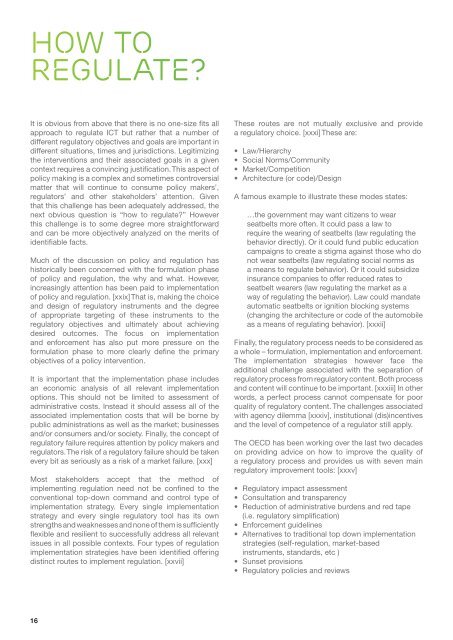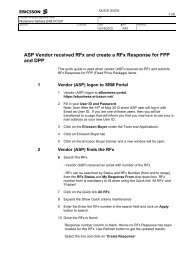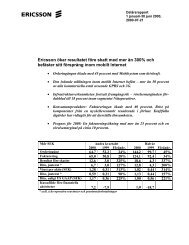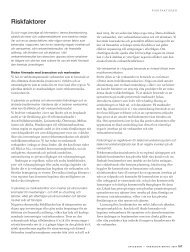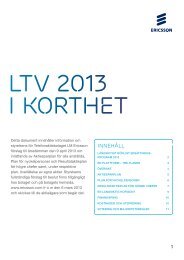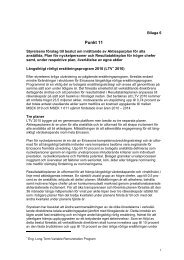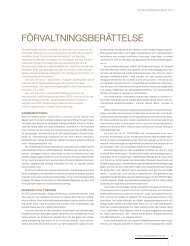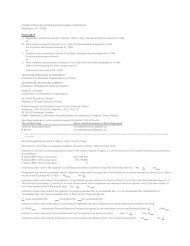ICT Policy For Networked Society - Ericsson
ICT Policy For Networked Society - Ericsson
ICT Policy For Networked Society - Ericsson
Create successful ePaper yourself
Turn your PDF publications into a flip-book with our unique Google optimized e-Paper software.
hOw TO<br />
REgULATE?<br />
It is obvious from above that there is no one-size fits all<br />
approach to regulate <strong>ICT</strong> but rather that a number of<br />
different regulatory objectives and goals are important in<br />
different situations, times and jurisdictions. Legitimizing<br />
the interventions and their associated goals in a given<br />
context requires a convincing justification. This aspect of<br />
policy making is a complex and sometimes controversial<br />
matter that will continue to consume policy makers’,<br />
regulators’ and other stakeholders’ attention. Given<br />
that this challenge has been adequately addressed, the<br />
next obvious question is “how to regulate?” However<br />
this challenge is to some degree more straightforward<br />
and can be more objectively analyzed on the merits of<br />
identifiable facts.<br />
Much of the discussion on policy and regulation has<br />
historically been concerned with the formulation phase<br />
of policy and regulation, the why and what. However,<br />
increasingly attention has been paid to implementation<br />
of policy and regulation. [xxix] That is, making the choice<br />
and design of regulatory instruments and the degree<br />
of appropriate targeting of these instruments to the<br />
regulatory objectives and ultimately about achieving<br />
desired outcomes. The focus on implementation<br />
and enforcement has also put more pressure on the<br />
formulation phase to more clearly define the primary<br />
objectives of a policy intervention.<br />
It is important that the implementation phase includes<br />
an economic analysis of all relevant implementation<br />
options. This should not be limited to assessment of<br />
administrative costs. Instead it should assess all of the<br />
associated implementation costs that will be borne by<br />
public administrations as well as the market; businesses<br />
and/or consumers and/or society. Finally, the concept of<br />
regulatory failure requires attention by policy makers and<br />
regulators. The risk of a regulatory failure should be taken<br />
every bit as seriously as a risk of a market failure. [xxx]<br />
Most stakeholders accept that the method of<br />
implementing regulation need not be confined to the<br />
conventional top-down command and control type of<br />
implementation strategy. Every single implementation<br />
strategy and every single regulatory tool has its own<br />
strengths and weaknesses and none of them is sufficiently<br />
flexible and resilient to successfully address all relevant<br />
issues in all possible contexts. Four types of regulation<br />
implementation strategies have been identified offering<br />
distinct routes to implement regulation. [xxvii]<br />
16<br />
These routes are not mutually exclusive and provide<br />
a regulatory choice. [xxxi] These are:<br />
• Law/Hierarchy<br />
• Social Norms/Community<br />
• Market/Competition<br />
• Architecture (or code)/Design<br />
A famous example to illustrate these modes states:<br />
…the government may want citizens to wear<br />
seatbelts more often. It could pass a law to<br />
require the wearing of seatbelts (law regulating the<br />
behavior directly). Or it could fund public education<br />
campaigns to create a stigma against those who do<br />
not wear seatbelts (law regulating social norms as<br />
a means to regulate behavior). Or it could subsidize<br />
insurance companies to offer reduced rates to<br />
seatbelt wearers (law regulating the market as a<br />
way of regulating the behavior). Law could mandate<br />
automatic seatbelts or ignition blocking systems<br />
(changing the architecture or code of the automobile<br />
as a means of regulating behavior). [xxxii]<br />
Finally, the regulatory process needs to be considered as<br />
a whole – formulation, implementation and enforcement.<br />
The implementation strategies however face the<br />
additional challenge associated with the separation of<br />
regulatory process from regulatory content. Both process<br />
and content will continue to be important. [xxxiii] In other<br />
words, a perfect process cannot compensate for poor<br />
quality of regulatory content. The challenges associated<br />
with agency dilemma [xxxiv], institutional (dis)incentives<br />
and the level of competence of a regulator still apply.<br />
The OECD has been working over the last two decades<br />
on providing advice on how to improve the quality of<br />
a regulatory process and provides us with seven main<br />
regulatory improvement tools: [xxxv]<br />
• Regulatory impact assessment<br />
• Consultation and transparency<br />
• Reduction of administrative burdens and red tape<br />
(i.e. regulatory simplification)<br />
• Enforcement guidelines<br />
• Alternatives to traditional top down implementation<br />
strategies (self-regulation, market-based<br />
instruments, standards, etc )<br />
• Sunset provisions<br />
• Regulatory policies and reviews


